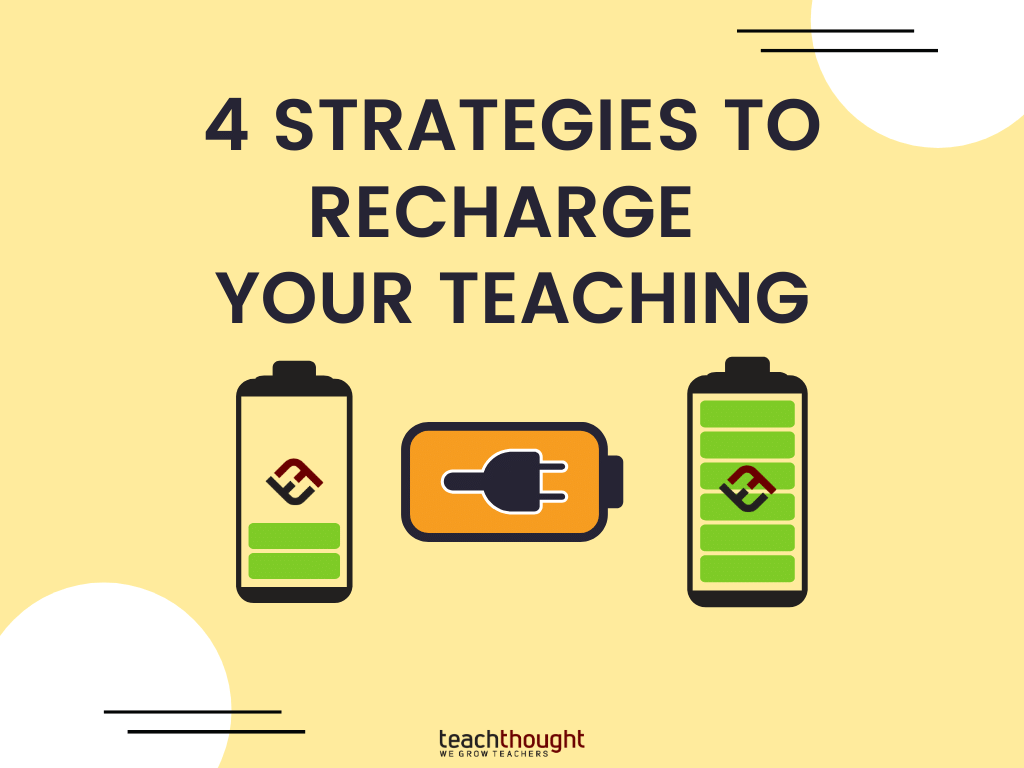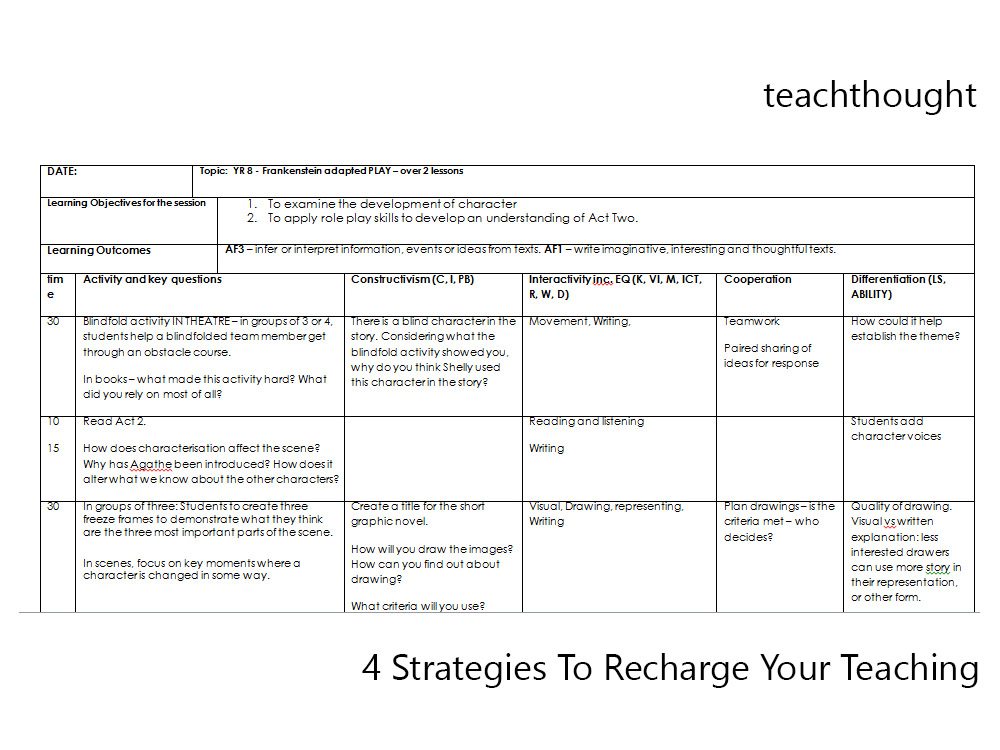
Recharge Your Teaching With These 4 Strategies
by TeachThought Staff
The last month of teaching was quite hard for me.
I found myself becoming increasingly frustrated in the classroom, less tolerant, less friendly, and worst of all, sarcastic. As a result, I became utterly exhausted. Something needed to change. I needed to take a step back and reflect on what was happening. Why had things changed? Where had the love gone?
Had the students changed, or was it me? It was of course me. And it all came down to planning. My lessons were boring, and so students were naturally disconnected more often. Their attention waned easily, and inevitably, their behavior deteriorated. As I looked back over my planning, I saw a lot of attention given to addressing outcomes, but a distinct lack of focus on deep learning.
I decided to invest some time into designing a new lesson plan template, forcing me to explicitly incorporate into my planning elements that I know work, which engage students, and satisfy epistemology inherent in me, which is reflected in the image below. Each lesson must incorporate several strategies that I’ve used to recharge my teaching: Constructivism, Movement, Collaboration and Differentiation.
 Constructivism: Who’s Making Meaning?
Constructivism: Who’s Making Meaning?
Does the learning activity encourage independent learning? Does it allow students to find the knowledge themselves, or am I giving it to them? Does it let them build upon existing knowledge by making connections? Does it involve some sort of inquiry, or problem where questions naturally and continually emerge, which leads to learning?
For me, constructivism is key to a successful learning environment. Students have a natural disposition to inquire, and lessons need to provide such opportunities. My teaching of late was lacking this. Rather, students were going through the motions, receiving information and being expected to apply it. The depth in the learning was missing because the students hadn’t fought for it themselves. They hadn’t discovered it for themselves; and so their connection to it was superficial.
In my planning now I ensure I am not only designing activities that promote independent thought, but that I also ask pertinent questions that initiate deep thinking. I also allow space for the likelihood of the lesson diverging from the track, realizing that that is the nature of constructivism. I think this is incredibly important: to honor that students’ interests will demand some veering from the path.
This doesn’t mean that the intended outcome can’t be reached. It just means that more time must be factored in, and the teacher must be skilled in promoting connections to bring it back to the original intention. The result is a deeper learning experience, as students have been engaged, and will have more ownership of their progress.
It’s about quality rather than quantity.
Interactivity: Do Students Move? Interact? With What, And Why?
To get students inquisitive, there needs to be suitable stimulus.
Interactivity is characterized by several elements, from the delivery method of the information, to the relevance of the learning. Explicitly planning for a variety of delivery is imperative. Everybody knows VAK, but so often I under-rate the importance of kinesthetic elements to an activity. And I don’t believe that writing is a sufficient kinesthetic activity. Students need to be physically active at some point in the lesson, whether it be moving around the room consulting other tables’ work, or adding ideas to a common board.
Even better is if students can learn about something through the body. For example, the other day in the Frankenstein unit I am teaching, to explore the idea of superficiality I had the students create and act out a short scene exploring the consequences of superficiality in a teen’s life. Yes it was messier than if I had just given them information, but every student now deeply understands the theme, as they learnt from their own and then their peers’ performances. This has now facilitated a deeper engagement in the text. Of course it’s a lot easier, and manageable, to ignore kinesthetic learning, but for so many students, it it is at the expense of engagement.
The learning at some point also needs to be relevant to the students. This can be achieved either through a thematic EQ (emotional intelligence) activity, a task based on interests, or a connection to a real world skill or application. I don’t care what anybody says: present students with boring resources, and the lesson will be poor.
Cooperation: Is There Collaboration?
Learning from peers is powerful, and helps strengthen constructivist experiences.
Often, students will seek their partner’s help to know what to do in a task, or to check if their learning is actually what was asked of them. Viewing a lesson back via video shows just how often this actually happens in a lesson, albeit surreptitiously, and rather than it being quashed, citing disruption as the rationale, let it flourish. Often, teachers try to quell such instances, demanding quiet, and individual learning, but by insisting on this at all times, valuable opportunities are foregone.
Students having opportunities to view others’ work from around the room is also effective. It’s one thing to know what the teacher is thinking, but knowing what their peers are thinking will spark greater stimulus as they relate, compete, challenge, and reshape their thinking – and deepen the learning experience. Social media is so pervasive in students’ lives because it satisfies these very elements. The massively untapped power of learning via social media will soon become a thing of the past, as teachers will begin to gain further access to existing platforms, and as new platforms aimed specifically at addressing safety for students and schools emerge.
Also, it is important to be aware of participation in class discussions. Lately, while some excellent conversations have occurred in my class, only the 5 or 6 participating in the discussion were engaged. The rest were not, and thus not learning. Asking questions and then getting students to discuss their thoughts with their partners, and then the table, encourages everyone to think, before the findings are offered to the class discussion. Kagan presents some very useful thinking and strategies in this area.
Differentiation: Just Enough, Just In Time, Just For Me
I focus on two aspects of this. Firstly, and obviously, is there a range of expectations in the task? Am I catering for all abilities, scaffolding certain tasks and providing increased challenge on demand? Have I consciously placed students on tables to maximize cooperative learning and to both push and support each other? Secondly, am I allowing and prompting variation in how students demonstrate their knowledge and understanding, or is everything written?
As an English teacher it can seem an overwhelming task to get students’ writing skills to the level required for exam success. However, when we only focus on such output, we deny students chances to deepen their engagement in the learning, and ironically, impede the development of the writing as students lose interest and connection with the subject. It takes a brave teacher to swim against the tide of teaching to the test, to trust that deeper engagement and a more well-rounded student will pay off in the long run (or swim).
But like you, in the name of progressive education, I will continue to do so.
Reflecting On My Own Journey
In hindsight, this last point was actually a significant reason for my disconnection over the last month.
I lost my spark for teaching momentarily. I lost sight of why I bother to spend 50 odd hours a week doing it. The learning was becoming prescriptive, narrow, sterile and shallow. My new lesson plan template however forces me to be more conscious of the things I value in my teaching. The template encourages deeper learning, deeper engagement, and inevitably, deeper satisfaction.
Even in the last few lessons where I’ve been using it, I feel re-energized, and refreshed. I am indeed back in business.